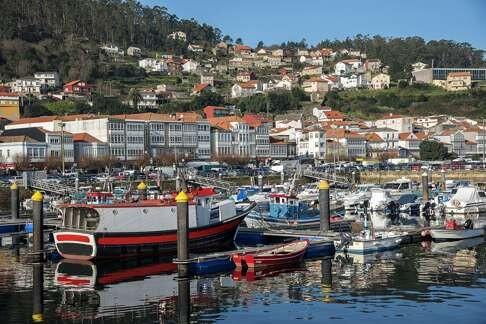A rainstorm of biblical proportions is sweeping across Santiago de Compostela. Seeing my heavenwards glance, the woman sitting next to me on the bus shakes her head dismissively.
“It’s just a shower. We’ve had a lot of sunny weather recently. It’ll be fine again tomorrow.”
I have my doubts. Galicia is Spain’s wettest region and Santiago de Compostela is the wettest part of Galicia. Locals are eternal optimists, however, and are fond of announcing: “Nunca choveu que non escampara” (“it has never rained without clearing afterwards”).
You don’t have to be a pilgrim to appreciate the city, although it helps. According to legend, the remains of Spain’s patron saint, James the Apostle, were discovered here in the 9th century, elevating Santiago’s status and sowing the seeds of a pilgrimage (tourism) industry that shows no signs of slowing. In 2015, more than a quarter of a million people from 178 countries completed the Camino de Santiago, or Way of St James, on foot, bicycle, horse and even by wheelchair.
I feel slightly underwhelmed on reaching Praza do Obradoiro, the main square; partly because I haven’t walked 790km to be here but also because the cathedral is cloaked in scaffolding. Those sinking to their knees around me seem to barely notice.
Clutching their certificates of accomplishment, or compostelas, groups of soggy, exhausted pilgrims gaze up at the Romanesque structure in disbelief. Some wear beatific smiles as they hug, pray and pose for “we made it” photos. Others, overcome with emotion, break down in tears. It’s enough to turn cynics into believers.
Santiago is more than a place to finish a lengthy hike, though. Wander the atmospheric streets of the old town, where baroque plazas, renaissance courtyards and neoclassical palaces glisten in the rain; browse antique stalls beneath ancient arches and watch housewives haggle for regional cheeses, artisan breads and shellfish at Abastos Market.
With its strong emphasis on seafood, Galician cuisine is a tourist attraction in its own right. I dip my toe in by sampling the merluza a la gallega, or Galician-style hake. The hearty fish and potato dish pairs well with crisp Albariño white wine, which numbs the senses enough to drown out the blaring television set in the corner and the busking bagpiper outside.
Depending on which scholar you side with, Galicia’s Celtic roots extend beyond pipers and potatoes. The language is closely related to Portuguese and Spanish but includes many words of Celtic origin. Evidence further extends to pagan rituals, festivals and age-old legends – Galicia is still known as terra de meigas, or land of witches.
Regardless of whether the Celtic connection is fact or fairy tale, there are some parallels that no academic would deny. Like the Scots and Irish, Galicians have emigrated far and wide, often as a result of economic hardship. There’s a shared fondness for traditional music; the love of a good party and the luminous green landscapes are more reminiscent of nations to the north than sun-burnished Spain.
Hot spots: Hostal Dos Reis Catolicos, Santiago de Compostela
As if by magic, the following day brings clear blue skies and a warm breeze. Locals, familiar with the vagaries of the Galician climate, play safe and dress for cool, showery conditions. The receptionist in my hotel grumbles about the humidity until I tell her she can’t expect much sympathy from someone who lives in Hong Kong.
I start out for the seaside, determined to explore the beaches and fjord-like estuaries before the weather reverts to its default Galician setting. Over the centuries, countless ships have been ripped apart in savage storms along a desolate stretch of wind-whipped shoreline known as the Costa da Morte. Fortunately, on this April morning, the Coast of Death is delightful rather than deadly.
Broad sandy beaches are deserted and the pine tree-flanked roads are almost vehicle free. I get stuck behind dawdling tractors, but there’s no hurry. Holiday townsfolk, not yet jaded by the high-season hordes, welcome the occasional visitor and are grateful for the custom. It’s Spain alright, but far removed from the overdeveloped Mediterranean costas.
A second successive day of sunshine counts as a minor miracle in these parts. I take it as a sign I should return to the car-hire office. First stop is the fishing port of Muros. Trawlers come and go, seagulls squawk and staff at pulperías (octopus restaurants) chalk up daily specials.
At Lariño I have the powder-white sands to myself and in sunny Ézaro the only sight more dazzling than the brightly painted houses is the electric turquoise of the Atlantic.
The weather turns suitably menacing at Finisterre, which derives its name from the Latin finis terrae, meaning “end of the earth”. The isolated cape is an optional four-day extension for pilgrims unable to stop walking. After taking in the views and photographing the lighthouse, modern tradition dictates that those who make it this far say a prayer and burn their hiking boots. No doubt a few masochists continue on to Portugal in their bare feet.
“A prayer to the patron saint of blisters?” I call out to a couple, thinking myself ever so witty.
“You mean St Blaise? We did that before we set off,” comes the deadpan response.
Driving rain pelts the windscreen on my approach to the harbour town of Cee, which is pronounced like a lisping hiccup. I pause at a café to confirm the existence of St Blaise and to ponder why the term “Celtic weather” isn’t in common usage.
Back in Santiago, the city is gearing up for a festival. Children dressed as mini matadors and flamenco dancers take great delight in being photographed by parents and pilgrims as they strut their stuff. The adults will begin their celebrations after dark and continue long into the night.
No doubt there will be a few with sore heads in the morning but a prayer to St Bibiana should do the trick. The 4th-century martyr is the patron saint of hangovers.











